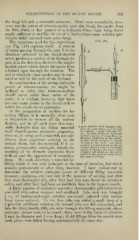Page 799 - My FlipBook
P. 799
FERMENTATION IN THE HUMAN MOUTH. 809
the fungi led only a miserable existence. Much more remarkable, how-
ever, was the action of tobacco-smoke upon the fungi, the smoke from
the first, third, or last quarter of a Colorado Claro cigar being found
amply sufficient to sterilize 10 c.c. of a beef-extract-sugar solution pre-
viously richly infected with caries fungi.
The apparatus used for this experiment Fig. 418.
(see Fig. 418) explains itself. A current
of water passing through the part B in the
direction indicated by the double-headed
arrow produces a current of air through the
part A in the direction shown by the single- a
headed arrow which draws the smoke from
a lighted cigar through the solution. The
rate at which the cigar smokes may be regu-
lated at will by the cock of the hydrant.
In consideration of the strong antiseptic
power of tobacco-smoke, we might be V
inclined to infer that tobacco-smokers
should never suffer from caries of the
teeth ; it is evident, however, that there
are very many points in the dental arch to
which the smoke never penetrates.
In the preparation of cavities for in-
serting fillings it is naturally often next
to impossible to remove all the carious
dentine, and in all such cases it is espe-
a, glass cylinder with infected solu-
ciallv desirable that the filling; material
tion 6, c, glass tubes; ;
itself should possess antiseptic properties, ber tubing; f, cigar (Colorado Cla-
ro) ; B, water air-i)unip. A current
since we, in using such a material, not only of water passing through B in the
direction indicated by the double-
destroy those organisms existing in the headed iirrow produces a partial
vacuum in the bulb, and conse-
carious tissue, but the material, if it re-
quently a current of air in the di-
mains permanently antiseptic, retards the rection shown by the single-headed
arrow, or through the cigar, which
working of the ferment organisms from if lighted will smoke at a I'ate deter-
mined by the pressure under which
without and the appearance of secondary
the water is llowiug.
decay. We need, therefore, a material for
filling which is not only antiseptic at the time of insertion, but which
remains permanently so after being inserted. I have endeavored to
determine the relative antiseptic power of different filling materials
(cements, amalgams, etc.) not only at the moment of mixing, but after
they were thoroughly dry, af^er they had lain some hours in sweetened
saliva, and after they had been an indefinite time in the human mouth.
A large number of miniature test-tubes (homeopathic pill-tubes) were
provided with cotton stoppers and sterilized. Into each was brought
h c.c. of beef-extract-sugar solution previously infected with carious
fungi (pure culture). To the first tube was added a small drop of a
1-per-cent. sublimate solution, the second tube was left untouched, and
into the third, fourth, fifth, etc. wei^e brought the filling materials whose
antiseptic virtues were to be tested ; these were in the form of cylinders
2 ram. in diameter and 3 mm. long ; if old fillings from the mouth were
used, pieces were taken having approximately the same size.


